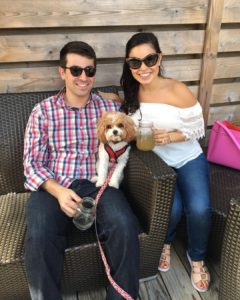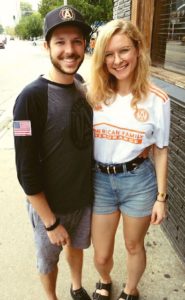The recent Brandeis study Beyond Welcoming: Engaging Intermarried Couples in Jewish Life affirmed the work of Honeymoon Israel as we welcome the 100th group of Honeymoon Israel participants to Israel in a few weeks. After four years of running trips, 2,000 couples from 20 different North American cities have participated and have had the opportunity to be embraced by the Jewish community and to build their own communities of young couples that will hopefully last for many years.
Consonant with the Brandeis study, we have found increased interest recently from the organized Jewish community to become more welcoming. Specifically, we now have broad-based support to welcome the ever-growing diversity and range of young couples with at least one Jewish partner to Jewish life.
While opening doors for initial engagement of these couples in Jewish life is important, sustained and meaningful engagement with them depends on how much we empower young couples to create their own Jewish communities. To that end, we believe that it’s critical that our own leadership reflect the diversity of our constituency. Over the past few months, we’ve begun to “staff up” and we’ve recently hired five new team members. More than 60 Honeymoon Israel participants applied for these jobs and more than half of them were non-Jews.
Three newly-hired Honeymoon Israel national team members are non-Jewish Honeymoon Israel participants. They were so inspired by their new community that they want to make it a part of their careers. As we embrace them as part of the Jewish family, we also encourage them to lead the organization and their community into the future. Their reflections on why they chose to work for Honeymoon Israel, and their experiences thus far, affirm the importance of proactively inviting young couples of all kinds into Jewish life experiences.
 Laura Cuellar Bernstein is the new Director of Marketing and participated in a New York Honeymoon Israel trip in February 2018. “Being part of Honeymoon Israel as alumni has been transformative for us. My husband’s family is Jewish and my family is Catholic. As we navigate the intricacies of creating an interfaith family, we’ve explored the commonalities between our faiths, cultures, and traditions. We often find that these point to the same core values: love, respect, and family,” said Bernstein. “Through this experience, we’ve become so close with the couples we met and it’s been incredible to have this community by our side. Honeymoon Israel has given us the support, space, and tools to confidently and meaningfully bring tradition and faith into our home.”
Laura Cuellar Bernstein is the new Director of Marketing and participated in a New York Honeymoon Israel trip in February 2018. “Being part of Honeymoon Israel as alumni has been transformative for us. My husband’s family is Jewish and my family is Catholic. As we navigate the intricacies of creating an interfaith family, we’ve explored the commonalities between our faiths, cultures, and traditions. We often find that these point to the same core values: love, respect, and family,” said Bernstein. “Through this experience, we’ve become so close with the couples we met and it’s been incredible to have this community by our side. Honeymoon Israel has given us the support, space, and tools to confidently and meaningfully bring tradition and faith into our home.”
 Laura Parker is the new Applicant Experience Manager. She and her husband Harrison Benett participated in an Atlanta Honeymoon Israel trip in May 2019. “I applied to go on the trip because my husband and I found during our wedding planning that we would not be welcomed in the community I grew up in (Southern Baptist), but we were both welcomed into the Jewish community. After our wedding, we began looking to expand our Jewish community from one couple to have over to Shabbat to many,” said Parker. “I fell in love with the intentional community-building while in Israel. Our trip leader and Rabbi led thought-provoking questions, unique Shabbat experiences, and quiet moments with partners that brought a diverse group of 40 adults to bond together in 9 days. I knew before boarding the plane back home that I wanted to work for Honeymoon Israel. The community has been so impactful in my personal and professional life. I am so honored and excited to be a part of a team that will give other couples across the nation (and Canada) an opportunity to build intentional Jewish communities, no matter their background.”
Laura Parker is the new Applicant Experience Manager. She and her husband Harrison Benett participated in an Atlanta Honeymoon Israel trip in May 2019. “I applied to go on the trip because my husband and I found during our wedding planning that we would not be welcomed in the community I grew up in (Southern Baptist), but we were both welcomed into the Jewish community. After our wedding, we began looking to expand our Jewish community from one couple to have over to Shabbat to many,” said Parker. “I fell in love with the intentional community-building while in Israel. Our trip leader and Rabbi led thought-provoking questions, unique Shabbat experiences, and quiet moments with partners that brought a diverse group of 40 adults to bond together in 9 days. I knew before boarding the plane back home that I wanted to work for Honeymoon Israel. The community has been so impactful in my personal and professional life. I am so honored and excited to be a part of a team that will give other couples across the nation (and Canada) an opportunity to build intentional Jewish communities, no matter their background.”
 Hannah Smith, Administrative Coordinator, also participated in a Honeymoon Israel trip out of Atlanta. “My partner and I chose to participate in Honeymoon Israel because we were searching for ways to connect with Judaism and incorporate it in a meaningful way in our daily life. The idea of a life-changing ten day trip to Israel with 19 other adventure-loving couples who were also searching for answers seemed almost too good to be true, but we knew we would regret not applying! We ended up having one of the most beautiful, fun, eventful, surreal, informative, and spiritual journeys with our Honeymoon Israel family. We made memories that will last us a lifetime, we found answers to questions we had for years, and we came back with even more questions and ideas that we love exploring and learning about daily. We were also pleased to find that Honeymoon Israel facilitates community building and supplies a wealth of resources for all of the couples once they get home. The staff, as well as fellow alumni, work so hard to assist with Jewish learning and fun events so that we can all stay connected.”
Hannah Smith, Administrative Coordinator, also participated in a Honeymoon Israel trip out of Atlanta. “My partner and I chose to participate in Honeymoon Israel because we were searching for ways to connect with Judaism and incorporate it in a meaningful way in our daily life. The idea of a life-changing ten day trip to Israel with 19 other adventure-loving couples who were also searching for answers seemed almost too good to be true, but we knew we would regret not applying! We ended up having one of the most beautiful, fun, eventful, surreal, informative, and spiritual journeys with our Honeymoon Israel family. We made memories that will last us a lifetime, we found answers to questions we had for years, and we came back with even more questions and ideas that we love exploring and learning about daily. We were also pleased to find that Honeymoon Israel facilitates community building and supplies a wealth of resources for all of the couples once they get home. The staff, as well as fellow alumni, work so hard to assist with Jewish learning and fun events so that we can all stay connected.”
Smith and Parker both knew during their trip that they wanted to be part of the Honeymoon Israel team. Smith adds, “I knew I wanted to work for Honeymoon Israel because I wanted a fulfilling and worthwhile career at an organization that I truly believe in.”
For Bernstein, it was the mission that made her eager to join as an employee. “Before we applied for Honeymoon Israel, my husband and I were skeptical that the organization had a hidden agenda. We were both happily surprised and blown away to find that it’s truly the open and accepting place it says it is. This is what made me want to be part of the team. It’s important to me to create a culture where diversity and understanding are prioritized and celebrated.”
Beyond a career, Honeymoon Israel is designed to provide a community for the alumni on the team. “The community I have found both as a Honeymoon Israel alumnus and now as an employee has meant an immense deal to me. As the non-Jewish partner in my relationship and as someone who has never belonged to any religion/community, I found both spiritual and social connections with Judaism and with Honeymoon Israel,” adds Smith.
The Brandeis study illuminates the reasons why couples with Jewish and non-Jewish partners are less engaged in Jewish life and emphasizes the need to move from welcoming to offering proactive invitations. Young couples want a “way in” to explore and make their own decisions regarding their emerging family’s Jewish identity and life experiences.
We are committed to ensuring that our growing staff and Board of Directors are comprised of all members of the “HMI Family.” This isn’t just a matter of being inclusive—this is a smart business practice. HMI, like other organizations, wants employees deeply committed to and passionate about our mission. We want employees who understand and can relate to all of our audiences so we can best reach, engage, and serve all of those audiences.
As more and more Jewish organizations evolve to be more proactively inclusive, we hope that the next wave of community professionals and board leadership reflects the diverse constituencies they serve. We’re proud that HMI has helped young couples connect with each other and build Jewish community in meaningful ways. Equally as important, we believe, is what is affirmed in the reflections above. When non-Jewish adults experience a warm and inviting Jewish community, in some instances they not only want to join that community, they also look to lead and to welcome others in as well.
Avi Rubel and Mike Wise are Co-CEOs of Honeymoon Israel